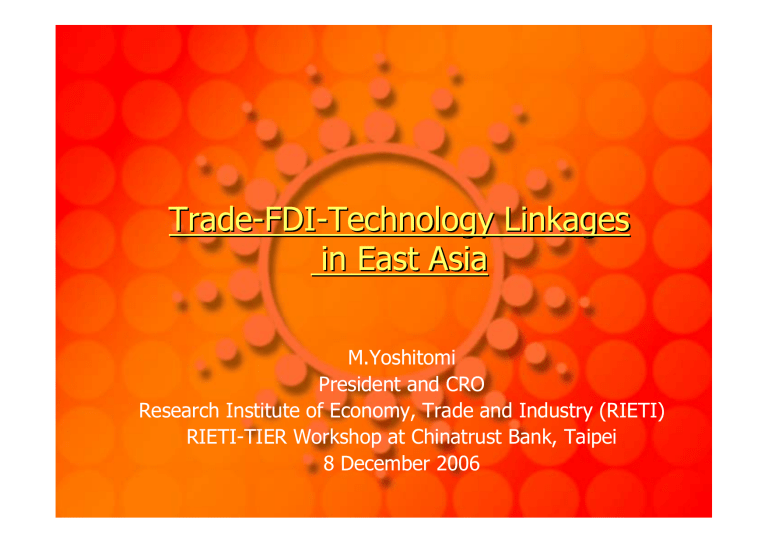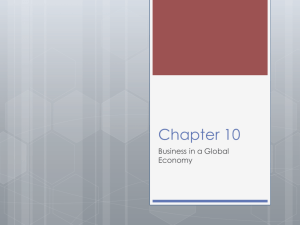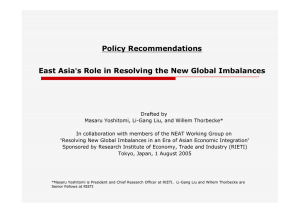Trade - FDI Technology Linkages

Trade FDI Technology Linkages in East Asia
M.Yoshitomi
President and CRO
Research Institute of Economy, Trade and Industry (RIETI)
RIETI-TIER Workshop at Chinatrust Bank, Taipei
8 December 2006
Index of Contents
Trade-FDI-Technology Linkages in East Asia
Introduction
I.
Mechanisms of global triangular trading patterns in East Asia
II. Another global value chains connecting from U.S. to Taiwan and China?
-How different from East Asian production networks-
III. Policy Issues
IV. Sharp differences between China and India
2
Trade-FDI-Technology Linkages in East Asia
Introduction
(1) Multinational firms have established production networks in
East Asia.
(2) How? By splitting up processes and reallocating production blocks across the region based on relative endowments of capital, skill, labour and physical and institutional infrastructure.
(3) The resulting efficiency gains have been enormous.
3
I. Mechanisms of global triangular trading patterns in East Asia
(1) Rapid increases in international trade of intermediate goods ( see ①)
(2) China’s role in global triangular trade
(a) China imports intermediate goods mainly from other
East Asia, not many from U.S.
( see ②)
(b) China then exports processed goods to all over the world market including the U.S.
( see ③)
(c) A result is China’s trade deficit with other East Asia but
China’s surplus with the U.S. ( see ④)
(3) Continued rises in both the exports/GDP and import/GDP ratios in East Asia ( see ⑤)
4
①
5
②
6
③
7
④
8
Figure 20: Exports and Imports of Goods by East Asia
(excluding Japan)
50
45
40
35
30
25
20
15
10
5
0
1993 1995
Total Exports
1997 Year 1999
Total Imports
2001 2003
Note : East Asia excluding Japan includes China, Indonesia, Malaysia, Philippines,
Republic of Korea, Thailand, and Taiwan.
Source : CEPII-CHELEM Database
9
⑤
II. Another global value chains connecting from U.S. to
Taiwan and China?
-How different from East Asian production networks-
(1) More than 80% of international production of the notebook PCs in the Yangtze River Delta of China
10
(a) Only in the late 2001, Taiwan government de-regulated
“outgoing” FDI of the Taiwanese notebook PC companies into China.
(b) Taiwanese ODMs had sometimes to accompany professional suppliers
(2) Multi-layered production networks
(a) high-value added suppliers of OS and MPU
(b) internationally well-known brand makers
(c) Taiwanese ODMs, professional first suppliers, consisting of
(i) 50~100 relatively large scale firms
(ii) several to ten thousand employees per firm
(iii) highly professional suppliers of connectors, batteries, switches, displays, etc
11
(d) a large number of producers of basic industrial materials
(i) several thousands of small-medium scale firms
(ii) varying number of employees around a few hundreds
(iii) engaged in casting, forging, plating, module assembling, etc: these are manufacturing base
(e) second and third suppliers, Taiwanese and Chinese
12
(3) Handling great uncertainties and risks
(a) High degree of uncertainties:
(i) extremely rapid technological changes
(ii) volatilities of market demand
(iii) ever shorter product-cycles
(b) Adopt literally real time management systems regarding every aspect of production and transaction arrangements: “build to order” systems, through the use of ITCs
(c) A key management issue: how the global value chain can efficiently and effectively work when ITCs are utilized by brand makers and ODMs but not necessarily by all suppliers. Small-scale and large number of suppliers, in Mainland China, lack the digital network management
13
III. Policy Issues
(1) Service Link Costs
Governments should seek to lower costs of service link between production blocks in order to facilitate the functioning of the geographically separated blocks. Both physical and institutional infrastructure should be strengthened:
(a) Highways, container yards, and airports;
(b) ICT infrastructure; and
(c) Market-supporting institutional infrastructure: enforcement of laws, enforcement of private contracts, corporate governance, and legal remedies when firms violate intellectual property rights agreements, etc
14
(2) Technology Transfer
Public-private cooperation can help countries advance from imitation to assimilation and, finally, innovation.
(a) Both technology and managerial capability transfer are an essential element of this process.
(b) When indigenous workers are well educated, such transfer can be more effectively expedited.
(c) Since it takes some time for transferring technological and managerial capability, the long tenure of foreign firms in host countries is important. Therefore, it is necessary to sustain FDI-friendly environments, including consistent and coherent enforcement of laws and regulations at all governmental levels as well as stable macroeconomic fundamentals.
15
(d) A strong local knowledge base is also essential if firms are to become involved in engineering and design.
(e) To build this knowledge base, high quality education in science and mathematics at secondary school level and scientific training at university level is needed.
(3) Free Trade Agreements
To enhance the benefits and quality of free trade agreements (FTAs), it is important to reduce the scope of sensitive items in both developed and developing economies and to enlarge the area covered by individual FTAs.
16
(4) Bilateral Investment Treaties
(a) High quality bilateral investment treaties (BITs) should be used to attract and retain foreign investors in host countries.
(b) They should provide for:
(i) Investment protection (compensation for expropriation and fair and equitable treatment to avoid wrongful termination of government contracts);
(ii) Investment facilitation (transparency of relevant laws);
(iii) Investment liberalization (freer market access and national treatment); and
(iv) Dispute settlement
(c) Minimum standards, not necessarily high standards, should be satisfied, particularly about above (iv) as well as (i)
17
(5) Resolving global imbalances: Appropriate Policy Mix of
Exchange Rates and Domestic Demand
(a) Basic characteristics of new global imbalances
(i) Large US deficits
(ii) East Asian surpluses after the 1997-98 Asian capital account crisis
(iii) Issues of sustainability of the current account imbalances
(iv) Most important US policies: Increases domestic savings
18
Global Distribution of Current Account Surpluses (Net Capital Exports) and Current Account Deficits (Net Capital Imports) by Region and
Country, 2005
(As a percent of the world sum of current account surpluses or deficits)
Ⓐ
Source: International Monetary Fund, World Economic Outlook database as of April 2006
1: As measured by countries' current account surpluses (assuming errors and omissions are part of the capital and financial accounts). East Asia includes ASEAN plus China, South Korea, and Japan.
2 As measured by countries' current account deficits (assuming errors and omissions are part of the capital and financial accounts).
19
U.S. and East Asian Global and Bilateral Trade Balances, 2005
Ⓑ
20
Domestic Saving, Capital Formation, and Resource Gap, before and after the Crisis
Ⓒ
21
Ⓓ
Share of U.S. Assets in the Portfolios of Investors from the Rest of the World (ROW)
Note: Financial assets are defined as measuring net financial assets and excluding tangible assets such as real estate and durable goods.
Source: Bureau of Economic Analysis (2005), Blanchard et al. (2005), and Edwards (2005).
22
(b) In order both to expand domestic demand and to reduce too strong export-orientation in East Asia, the right policy mix will be indispensable, that is, simultaneous policies of both domestic absorption expansion and exchange rate appreciation. This is because domestic demand expansion policy alone without currency appreciation would lead to overheating.
(c) The domestic demand expansion policies include both physical and human infrastructure building (e.g., education particularly in rural areas), deregulation to promote competition and productivity growth in the non-tradable sector, and social safety nets so that consumers would have lesser need for precautionary savings.
(d) Free floating regimes would be inappropriate for developing countries in the region, but greater exchange rate flexibility in the context of a multiple currency basket-based reference rate with a wider band would be preferable.
23
(e) To sustain the efficient production networks in East Asia, relatively stable exchange rate relationships will be preferable among East Asian countries: coordinated exchange rate policies in the region.
(f) In addition, East Asian countries should consider seeking higher returns on their existing excess reserves
(those above what are needed to be prepared for a capital account crisis) by investing excess foreign reserves in external assets with risk-adjusted higher rates of return as compared with short-term US treasury bills. (please see the case of Singapore, ⑥ )
24
⑥
25
IV. Sharp differences between China and
India
Introduction
(1) Two Emerging Giants: China and India, with population of
1.3 billion and 1.0 billion, respectively, and high growth rates of 8~10 percent per annum.
(2) About 20 high growth Japans (her population of 0.13 billion) are emerging simultaneously? This is the thrust of the socalled globalization.
(3) However, sharp differences between China and India, regarding development processes.
26
Four basic differences
I. Exports of Goods versus Exports of Services
II. Different development path
III. Different impacts on advanced economies
IV. Different political regimes
27
Four basic differences
I. Exports of goods versus Exports of Services
(1) The value of exports of “goods” from China is ten times as large as that of India (“Made in China” is visible all over the world markets, but “Made in India” is not).
(2) This is because the Chinese economy is firmly embedded in the Eat Asian production networks: China imports a lot of technology-intensive intermediate goods from the rest of Asia
(Japan, Taiwan, Korea, ASEAN), processes them as final products (consumption and capital goods), and exports the final products all over the world markets.
(3) In contrast, the driving force of exports of India is software associated with semiconductors and computers, etc. In particular, US multinational companies outsource to India the development and production of software.
(4) In other words, India is embedded in the U.S. led global value chains.
28
II. Different development path
The above difference has given birth to the different paths of economic development.
(1) China absorbs the huge amount of primary and middle school graduates into the aforementioned processing exports, hence successful in the reduction of poverty very rapidly.
(2) In sharp contrast, Indian software industries absorb mainly college graduates, and hence the poverty reduction is rather slow.
29
III. Different impacts on advanced economies
(1) China threatens low-skill workers in advanced countries by exporting labor-intensive processed final goods and also by attracting FDI, thereby hollowing-out some industries in advanced economies.
(2) In contrast, India threatens advance counties, particularly, the
U.S., by taking out jobs in services such as data-processing, accounting, tax reports as well as call centers.
(3) Although services can not be internationally traded by installing them in containers, they can be easily traded, i.e., outsourced through the Internet, generating new types of
“trade” conflicts between emerging and advanced economies under globalization.
30
IV. Different political regimes
(1) China is a one party-based-authoritarian state, whereas India is a multi-parties-based-democratic state with general election.
(2) But, the economic development model in China is very similar to the model employed by many other East Asian countries particularly till the 1997-98 Asian financial crisis, that is, the mix of the authoritarian state and growthmanship (high growth policy).
(3) This East Asian development model has been successful, providing the authoritarian states with some foundation for legitimacy.
(4) However, this development model counters against the so-called
Washington consensus.
(5) In contrast, India suffered from the legacy of British colonization, for long time and, therefore, adopted socialistic policies of substituting imports and foreign technologies by her own domestic sources till the
1980s, resulting in just 2-3 percent low growth rates, failing to reduce massive poverty.
(6) But now, India exhibits a new development model of the democratic
Policy implications
(1) How to democratize China as quickly and smoothly as possible → through building an East Asian Economic
Community?
(2) How to integrate the Indian economy in the global production and value chain networks? → ASEAN+4 Economic
Community?
32





